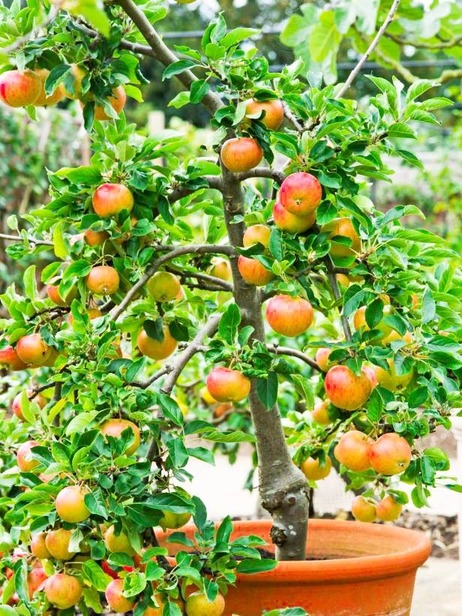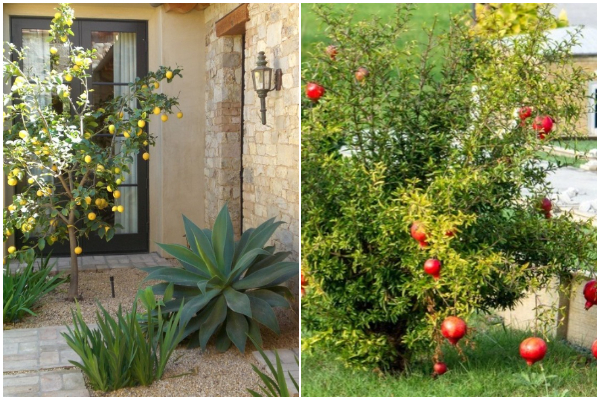Growing fruit in your front yard not only adds beauty to your home but also provides fresh, delicious produce right at your doorstep. Whether you’re looking to enhance curb appeal or enjoy the convenience of picking your own fruit, certain varieties thrive when planted in front of your house. In this article, we’ll explore the 6 best fruits to adorn your front yard, offering a blend of ornamental appeal and tasty harvests.
1. Lemon

Lemon trees are a lovely addition to any garden or orchard, with their delicate spring blossoms and bright yellow, tangy fruit. They make a great, compact choice for the front of your home and provide zesty lemons for your drinks and salads.
When grown in pots, these sun-loving plants can dry out quickly, so make sure to water them regularly. During winter, it’s important to bring them indoors to keep them warm since they are very sensitive to cold. If planting outdoors, choose the warmest spot you have, one that gets full sun and is sheltered from cold winds.
Lemon trees thrive best in areas with plenty of direct sunlight. They grow well in sandy, loamy, and well-drained soil, needing full sun and warmth to flourish.
These trees need plenty of water during the growing season and regular feeding with a nitrogen-rich fertilizer. Pruning is rarely necessary, making lemon tree care easier. Provide them with fertile, well-draining soil, ideally with a pH between 5.5 and 6.5. Fertilize them during the growing season to support healthy growth.
2. Oranges
 Orange trees are among the most well-known citrus trees, with lush, leafy canopies and fragrant flowers that give way to their popular fruit. A full-sized orange tree can grow up to 32 feet tall, while dwarf varieties reach about 12 feet. These trees are typically planted in the ground after the threat of frost has passed, but dwarf types can be planted in containers at any time, making them a great option for indoor gardening. While the fruit is delicious, the plant itself can be toxic to pets.
Orange trees are among the most well-known citrus trees, with lush, leafy canopies and fragrant flowers that give way to their popular fruit. A full-sized orange tree can grow up to 32 feet tall, while dwarf varieties reach about 12 feet. These trees are typically planted in the ground after the threat of frost has passed, but dwarf types can be planted in containers at any time, making them a great option for indoor gardening. While the fruit is delicious, the plant itself can be toxic to pets.
Smaller varieties like Calamondin and Trovita oranges are perfect for container growing. For potting, mix equal parts of peat moss, perlite, and vermiculite. Let the top inch of soil dry out before watering. You can use a whiskey barrel with drainage holes or a half-barrel for growing orange trees in pots on your patio.
Orange trees need plenty of sunshine and warmth to produce sweet fruit, so make sure they get eight to 10 hours of sun each day. If you’re growing dwarf varieties indoors, place them near a sunny window. They thrive in rich, loamy, well-draining soil and need consistent watering, but be careful not to let the soil become waterlogged.
3. Apple

Opt for compact, dwarf, or semi-dwarf apple trees to enjoy cool-climate fruits on your patio or at the front of your home. The size of the tree is also determined by its rootstock. Though it may take a few years to bear fruit, the wait is worthwhile.
Apple trees thrive in full sun and moist, well-drained soil but avoid planting them in low or waterlogged areas. When growing in pots, prune in late winter before new growth to manage size and boost fruit production.
For best results, ensure they get at least 8 hours of sun daily. Apple trees prefer slightly acidic, well-drained soil with a pH between 5.0 and 6.8, and they need to be planted near other apple or crabapple trees. To prevent pests and diseases, keep the area around them clear of debris, fallen fruit, and weeds throughout the year.
4. Persimmon

Persimmons are great for home gardens and are easy to plant. This sweet, juicy fruit can be very astringent when unripe but turns delicious when ripe. They thrive on warm, humid patios, making them ideal for moderate to hot climates. In the garden, persimmon trees can grow 30-70 feet tall, but in pots, they stay manageable at about 8-15 feet.
They need full sun and well-drained, slightly acidic to neutral soil. Repot them every two to three years with fresh soil, ensuring the container has enough space for root growth. You can grow persimmon trees from seeds, cuttings, suckers, or grafts. Transplant seedlings to an orchard after one to two years, but for the best results, opt for grafted or budded trees.
5. Fig

Figs, originally from Mediterranean regions, are tear-shaped fruits with red flesh, greenish skin, and many tiny crunchy seeds. Dwarf varieties like Little Miss Figgy are great for pots and are easy to care for, but almost any type can be grown. This small, deciduous tree has broad, eye-catching green leaves and thrives in full sun, needing at least 6 to 8 hours of direct sunlight each day. It prefers well-draining, loamy soil rich in organic matter. Young fig trees require at least a 5-gallon pot, but the pot size should increase as the tree grows. Consistent watering is crucial when the tree is fruiting.
Keep in mind that fig trees are toxic to dogs, cats, and horses, leading to digestive issues and skin irritation. Although the fruit is safe for people, fig leaves and sap can cause rashes, so it’s best to wear gloves when handling the tree.
6. Pomegranate

Pomegranate trees are eye-catching with their shiny leaves and funnel-shaped, orange flowers that bloom all summer, adding a pop of color to your patio even before the fruit appears. They produce apple-sized, pink fruit packed with juicy, sweet-tasting seeds called arils, commonly used in Middle Eastern dishes and salads. The bright red, tube-shaped flowers also attract hummingbirds and other pollinators.
The tree can vary in size from a small 3-foot shrub to a 30-foot tree. They are usually deciduous, but in warmer climates, they may stay evergreen. They don’t need large containers—a 12-inch pot is a good starting size.
If you live in a warm climate, pomegranates are easy to care for. It takes about 3 to 6 years for the trees to mature enough to produce their distinctive red, leathery fruit filled with edible seeds. Plant them in a sunny, sheltered spot with fertile, well-drained, and slightly alkaline soil. Prune only to remove dead or damaged branches, and mulch annually with well-rotted manure or compost.

